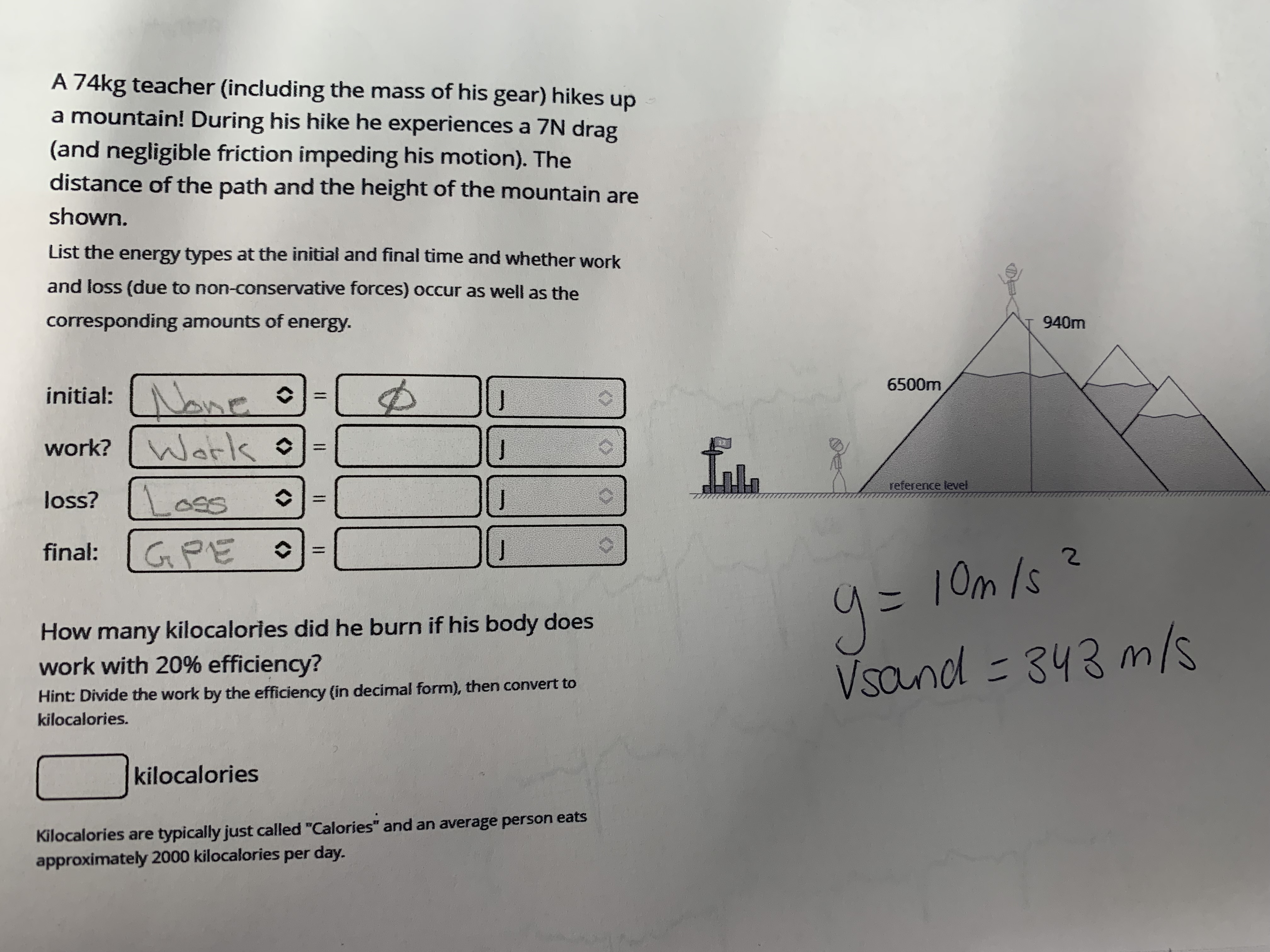Question
HI, please see attached image for question. Thank you

Transcribed Image Text:A 74kg teacher (including the mass of his gear) hikes
up
a mountain! During his hike he experiences a 7N drag
(and negligible friction impeding his motion). The
distance of the path and the height of the mountain are
shown.
List the energy types at the initial and final time and whether work
and loss (due to non-conservative forces) occur as well as the
corresponding amounts of energy.
940m
Noneo
work? / =
6500m
initial: ne •
Wark
reference level
loss? Loss
final:
GPE :
10m /s
How many kilocalories did he burn if his body does
work with 20% efficiency?
y=
Vsand = 343 m/s
Hint: Divide the work by the efficiency (in decimal form), then convert to
kilocalories.
kilocalories
Kilocalories are typically just called "Calories" and an average person eats
approximately 2000 kilocalories per day.
%3D
%3D
Expert Solution
This question has been solved!
Explore an expertly crafted, step-by-step solution for a thorough understanding of key concepts.
This is a popular solution
Trending nowThis is a popular solution!
Step by stepSolved in 5 steps with 8 images

Knowledge Booster
Similar questions
- Need help checking some practice problems. Image included, thanks!arrow_forwardPlease asaparrow_forwardAn optic is used to create an image. The image distance is 54 cm, the magnification is -0.5, & the object height is 29 cm. Determine the optic's focal length & the image height. TH h MY NOTES ASK YOUR TEACHERarrow_forward
- Please solve this problem using two approaches: a) Draw a ray diagram to locate the image b) Use the mirror & magnification equations to calculate the image distance (di) and image height (hi) (show your work)arrow_forwardPlease complete the following question:arrow_forwardStudent # S= Object Distance (cm) P= Image Distance (cm) F= Focal Length from Lens Formula (cm) 1 12 60 ? 2 14 35 ? 3 20 20 ? The form of the Lens formula used most commonly in physics is (1/p) + (1/s) = 1/f p= image distance s= object distance f= focal length 1. calculate the focal length for each of the combinations of s and p by use of the lens formula. average focal length: 2. use the lens formula to derive an equation that gives p in terms of s and f.arrow_forward
- Physics Question #49 is the attached imagearrow_forwardYou hold a spherical salad bowl 50 cm in front of your face with the bottom of the bowl facing you. The salad bowl is made of polished metal with a 44 cm radius of curvature. 1) Where is the image of your 5.0- cm -tall nose located? Follow the sign rules. Enter the magnitude of the distance from the salad bowl. Express your answer with the appropriate units. 2) What is the image's size? Express your answer with the appropriate units.arrow_forwardThe radius of the curvature for a converging mirror is 36 cm. What is its focal length, in cm? Your answer needs to have 2 significant figures, including the negative sign in your answer if needed. Do not include the positive sign if the answer is positive. No unit is needed in your answer, it is already given in the question statement.arrow_forward
- In the figure, the thin lens forms a real image of the object 94.0 cm from the object. What is the focal length of the lens? 9.70 mm Object 35.0 cm- Thin Lensarrow_forwardIf the distance of the object is 250 cm and the distance of the image is 140 cm, I say that the focal length is 390 cm. true or falsearrow_forwardThe image with the diagram serves as a reference for the second image with the actual question. Please answer the question on the image without the diagram.arrow_forward
arrow_back_ios
SEE MORE QUESTIONS
arrow_forward_ios